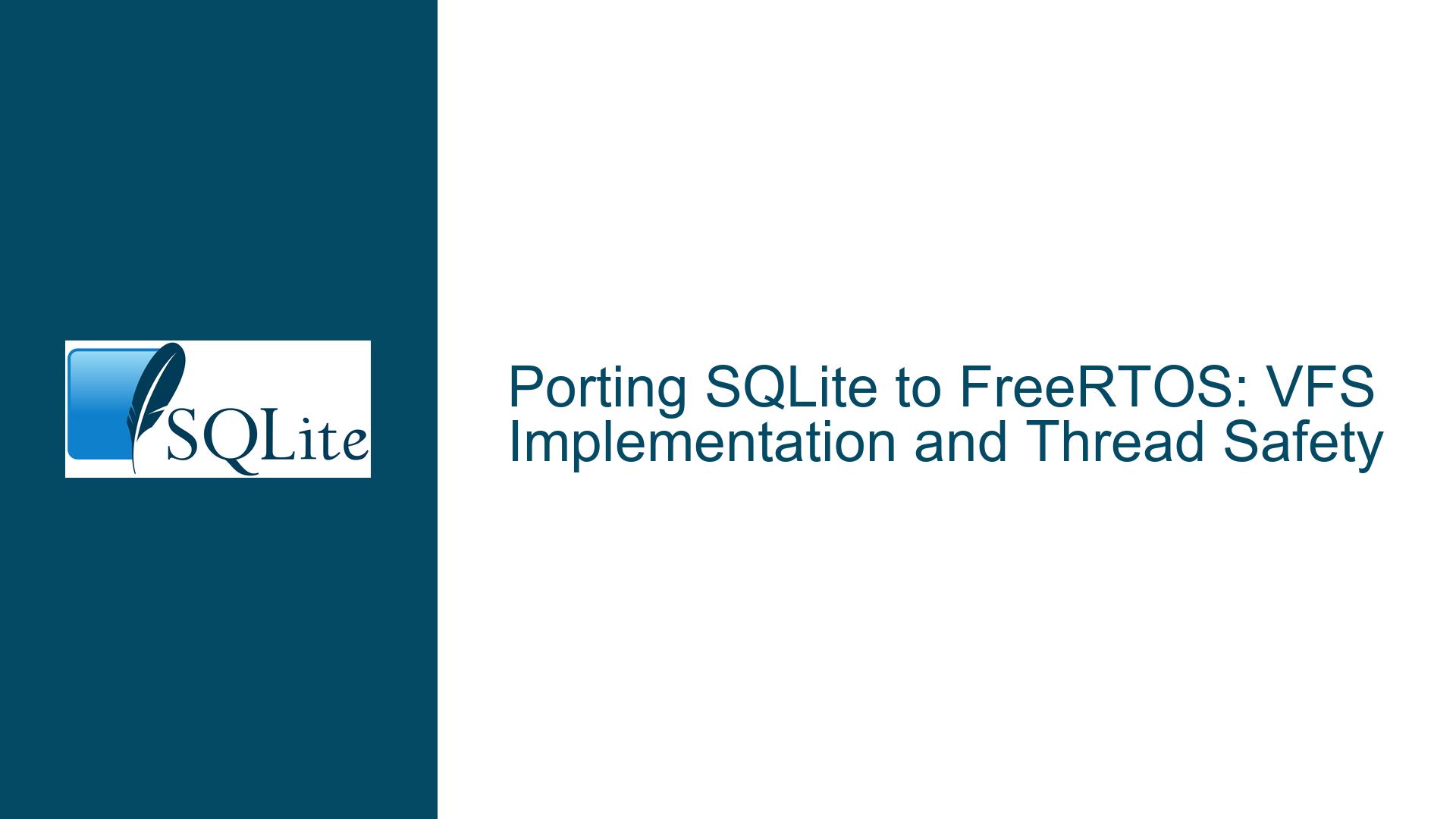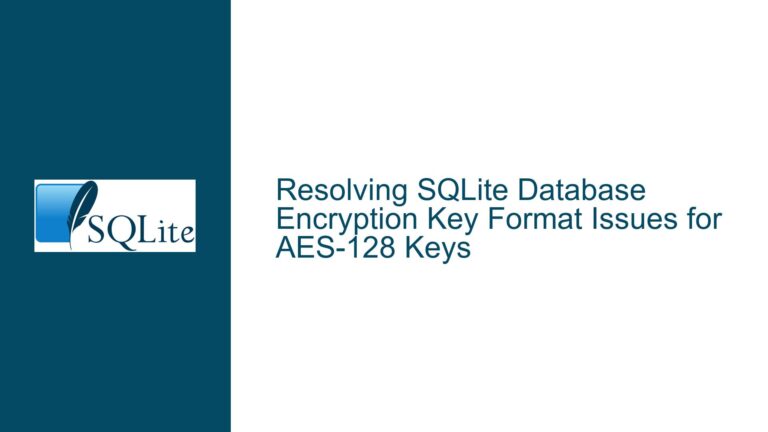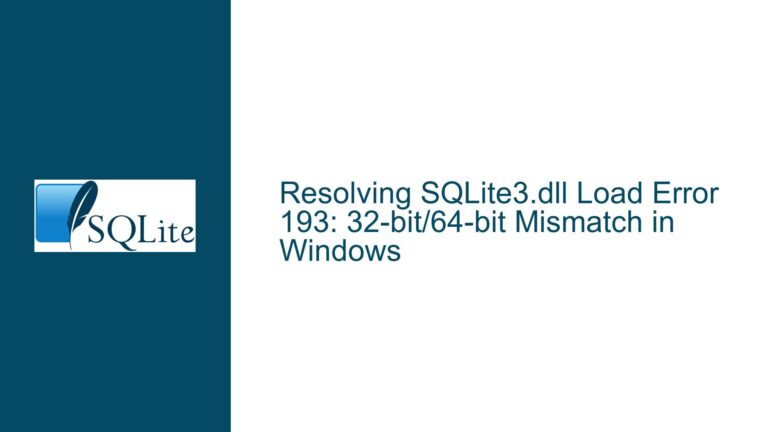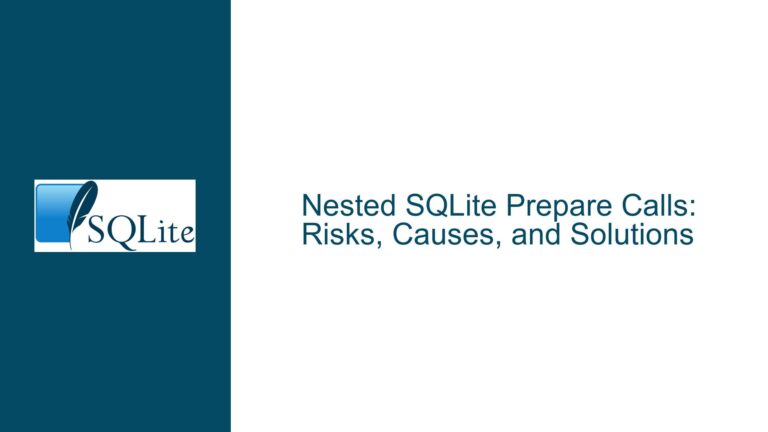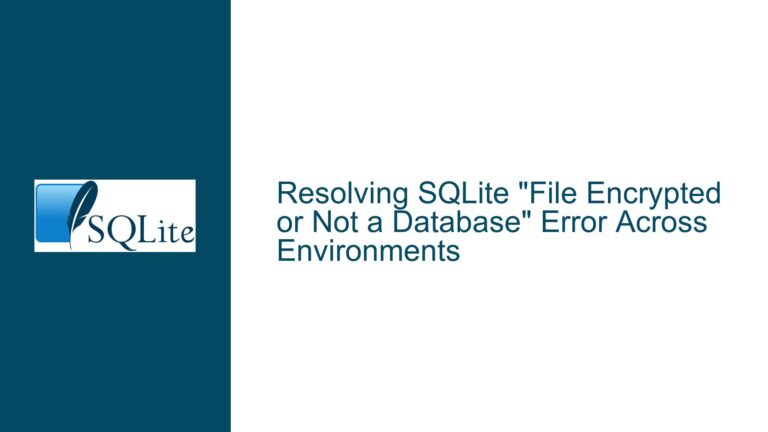Porting SQLite to FreeRTOS: VFS Implementation and Thread Safety
Understanding the SQLite VFS Layer and FreeRTOS Constraints
The core issue revolves around porting SQLite to FreeRTOS, specifically targeting microcontrollers like STM32F4 and nRF52832. SQLite, being a lightweight, serverless, and self-contained database engine, is highly portable. However, its portability relies heavily on the underlying operating system’s capabilities, particularly the Virtual File System (VFS) layer. FreeRTOS, being a real-time operating system designed for embedded systems, does not inherently provide the file system, locking mechanisms, or timing services that SQLite expects. This creates a significant challenge when attempting to integrate SQLite into a FreeRTOS environment.
The VFS layer in SQLite acts as an abstraction between the database engine and the underlying operating system. It handles file operations, such as opening, reading, writing, and closing files, as well as synchronization mechanisms like file locking. In a typical operating system like Linux or Windows, these services are readily available. However, FreeRTOS does not provide such services out of the box, necessitating the implementation of a custom VFS layer tailored to the specific hardware and FreeRTOS environment.
Additionally, SQLite’s thread safety is a critical consideration when porting to FreeRTOS. SQLite relies on mutexes to ensure that multiple threads can safely access the database concurrently. FreeRTOS provides its own mutex mechanisms, but integrating them with SQLite requires careful configuration and potentially modifying SQLite’s source code to use FreeRTOS-specific mutex functions.
Challenges in Implementing a Custom VFS Layer and Ensuring Thread Safety
The primary challenge in porting SQLite to FreeRTOS lies in implementing a custom VFS layer that can interface with the limited resources and services provided by FreeRTOS. This involves creating functions for file operations, such as opening, reading, writing, and closing files, as well as implementing file locking mechanisms to prevent data corruption in multi-threaded or multi-task environments.
Another significant challenge is ensuring thread safety. SQLite uses mutexes to protect critical sections of its code, ensuring that only one thread can access certain resources at a time. In FreeRTOS, mutexes are provided by the operating system, but SQLite must be configured to use these mutexes instead of its default implementations. This requires modifying SQLite’s source code or using compile-time options to replace SQLite’s mutex functions with FreeRTOS-compatible ones.
Furthermore, the integration of SQLite with a file system like FATFS adds another layer of complexity. FATFS is a popular file system for embedded systems, but it does not inherently support the locking mechanisms required by SQLite. This means that the custom VFS layer must also handle file locking in a way that is compatible with both SQLite and FATFS.
Step-by-Step Guide to Porting SQLite to FreeRTOS with FATFS
Step 1: Setting Up the Development Environment
Before attempting to port SQLite to FreeRTOS, ensure that your development environment is properly set up. This includes installing the necessary toolchains, such as GCC for ARM, and setting up your IDE (e.g., STM32CubeIDE or Keil) to compile and debug code for your target microcontroller (STM32F4 or nRF52832). Additionally, ensure that FreeRTOS and FATFS are correctly integrated into your project.
Step 2: Understanding SQLite’s VFS Layer
The first step in porting SQLite to FreeRTOS is to understand SQLite’s VFS layer. The VFS layer is defined in the sqlite3_vfs structure, which contains function pointers for various file operations. To create a custom VFS, you need to implement these functions and register the VFS with SQLite using the sqlite3_vfs_register function.
The key functions that need to be implemented include:
xOpen: Opens a file.xRead: Reads data from a file.xWrite: Writes data to a file.xClose: Closes a file.xLock: Locks a file.xUnlock: Unlocks a file.xCheckReservedLock: Checks if a file is locked.xFileSize: Gets the size of a file.xTruncate: Truncates a file to a specified size.xSync: Synchronizes a file with the underlying storage.
Step 3: Implementing the Custom VFS Layer
To implement the custom VFS layer, start by creating a new file (e.g., sqlite3_freertos_vfs.c) and defining the sqlite3_vfs structure. Each function pointer in the structure should point to a corresponding function that you will implement. For example, the xOpen function pointer should point to a function that opens a file using FATFS.
Here is an example of how to implement the xOpen function:
static int freertosVfsOpen(sqlite3_vfs *pVfs, const char *zName, sqlite3_file *pFile, int flags, int *pOutFlags) {
FIL *pFatFile = (FIL *)sqlite3_malloc(sizeof(FIL));
if (!pFatFile) {
return SQLITE_IOERR_NOMEM;
}
FRESULT result = f_open(pFatFile, zName, FA_READ | FA_WRITE);
if (result != FR_OK) {
sqlite3_free(pFatFile);
return SQLITE_CANTOPEN;
}
pFile->pMethods = &freertosVfsFileMethods;
pFile->pFatFile = pFatFile;
return SQLITE_OK;
}
In this example, f_open is a FATFS function that opens a file. The pFile structure is a SQLite file object that will be used in subsequent file operations. The pMethods pointer points to a structure containing function pointers for file operations, which you will also need to implement.
Step 4: Implementing File Operations
After implementing the xOpen function, you need to implement the other file operations, such as xRead, xWrite, xClose, and so on. Each of these functions should use the corresponding FATFS functions to perform the required operations.
For example, the xRead function might look like this:
static int freertosVfsRead(sqlite3_file *pFile, void *zBuf, int iAmt, sqlite3_int64 iOfst) {
FIL *pFatFile = (FIL *)pFile->pFatFile;
UINT bytesRead;
FRESULT result = f_lseek(pFatFile, iOfst);
if (result != FR_OK) {
return SQLITE_IOERR_READ;
}
result = f_read(pFatFile, zBuf, iAmt, &bytesRead);
if (result != FR_OK || bytesRead != iAmt) {
return SQLITE_IOERR_READ;
}
return SQLITE_OK;
}
In this example, f_lseek is used to move the file pointer to the specified offset, and f_read is used to read the specified number of bytes from the file.
Step 5: Implementing File Locking
File locking is crucial for ensuring data integrity in a multi-threaded or multi-task environment. SQLite uses file locks to prevent multiple threads or tasks from writing to the database simultaneously. In FreeRTOS, you can use mutexes to implement file locking.
To implement file locking, you need to modify the xLock, xUnlock, and xCheckReservedLock functions in your custom VFS. For example, the xLock function might look like this:
static int freertosVfsLock(sqlite3_file *pFile, int lockType) {
FIL *pFatFile = (FIL *)pFile->pFatFile;
if (lockType == SQLITE_LOCK_SHARED) {
// Acquire a shared lock
if (xSemaphoreTake(pFatFile->sharedMutex, portMAX_DELAY) != pdTRUE) {
return SQLITE_BUSY;
}
} else if (lockType == SQLITE_LOCK_EXCLUSIVE) {
// Acquire an exclusive lock
if (xSemaphoreTake(pFatFile->exclusiveMutex, portMAX_DELAY) != pdTRUE) {
return SQLITE_BUSY;
}
}
return SQLITE_OK;
}
In this example, xSemaphoreTake is a FreeRTOS function that acquires a mutex. The sharedMutex and exclusiveMutex are FreeRTOS mutexes that you need to create and initialize when the file is opened.
Step 6: Ensuring Thread Safety
To ensure thread safety, you need to configure SQLite to use FreeRTOS mutexes instead of its default mutex implementations. This can be done by modifying SQLite’s source code or using compile-time options.
One approach is to define the SQLITE_MUTEX_FREERTOS macro and implement the necessary mutex functions using FreeRTOS mutexes. For example:
#define SQLITE_MUTEX_FREERTOS 1
static sqlite3_mutex *freertosMutexAlloc(int id) {
sqlite3_mutex *pMutex = (sqlite3_mutex *)sqlite3_malloc(sizeof(sqlite3_mutex));
if (pMutex) {
pMutex->mutex = xSemaphoreCreateMutex();
if (!pMutex->mutex) {
sqlite3_free(pMutex);
return NULL;
}
}
return pMutex;
}
static void freertosMutexFree(sqlite3_mutex *pMutex) {
if (pMutex) {
vSemaphoreDelete(pMutex->mutex);
sqlite3_free(pMutex);
}
}
static void freertosMutexEnter(sqlite3_mutex *pMutex) {
xSemaphoreTake(pMutex->mutex, portMAX_DELAY);
}
static void freertosMutexLeave(sqlite3_mutex *pMutex) {
xSemaphoreGive(pMutex->mutex);
}
In this example, xSemaphoreCreateMutex, vSemaphoreDelete, xSemaphoreTake, and xSemaphoreGive are FreeRTOS functions used to create, delete, acquire, and release mutexes, respectively.
Step 7: Testing and Debugging
After implementing the custom VFS layer and ensuring thread safety, the next step is to test the implementation. Start by creating a simple SQLite database and performing basic operations, such as creating tables, inserting data, and querying data. Use FreeRTOS tasks to simulate multiple threads accessing the database concurrently.
If you encounter any issues, use debugging tools, such as breakpoints and logging, to identify the problem. Pay particular attention to file locking and mutex operations, as these are common sources of errors in multi-threaded environments.
Step 8: Optimizing for Embedded Systems
Finally, consider optimizing SQLite for the limited resources of your embedded system. SQLite provides several compile-time options to reduce its footprint, such as disabling unused features (e.g., SQLITE_OMIT_TRIGGER, SQLITE_OMIT_VIEW) and enabling memory-saving options (e.g., SQLITE_DEFAULT_MEMSTATUS=0, SQLITE_DEFAULT_WAL_SYNCHRONOUS=1).
Additionally, consider using SQLite’s PRAGMA statements to optimize database performance, such as PRAGMA journal_mode=WAL for faster write operations and PRAGMA synchronous=NORMAL for a balance between performance and data integrity.
Conclusion
Porting SQLite to FreeRTOS involves implementing a custom VFS layer to handle file operations and ensuring thread safety by integrating FreeRTOS mutexes. By following the steps outlined in this guide, you can successfully integrate SQLite into your FreeRTOS-based embedded system, enabling robust and efficient data storage and retrieval.
